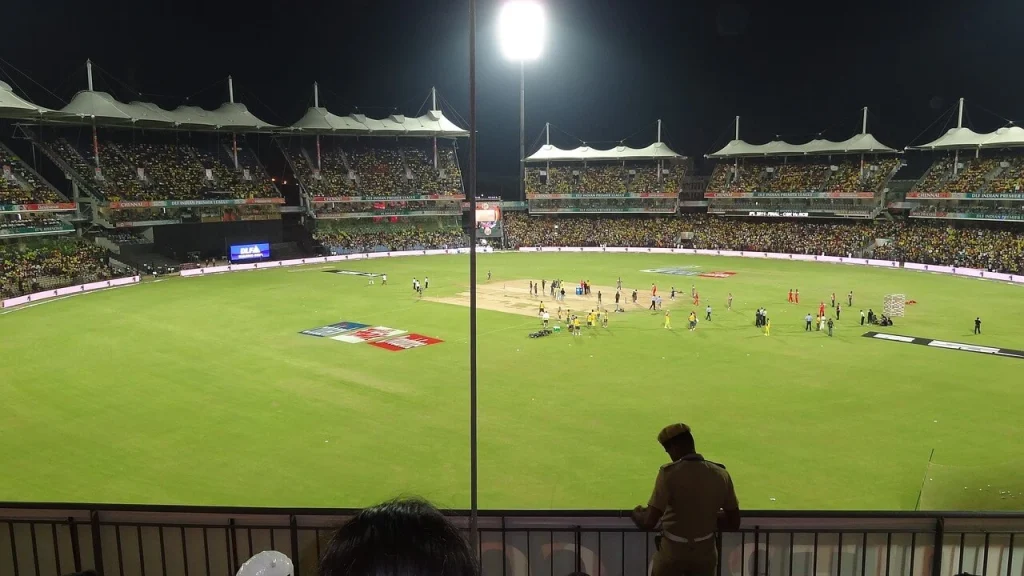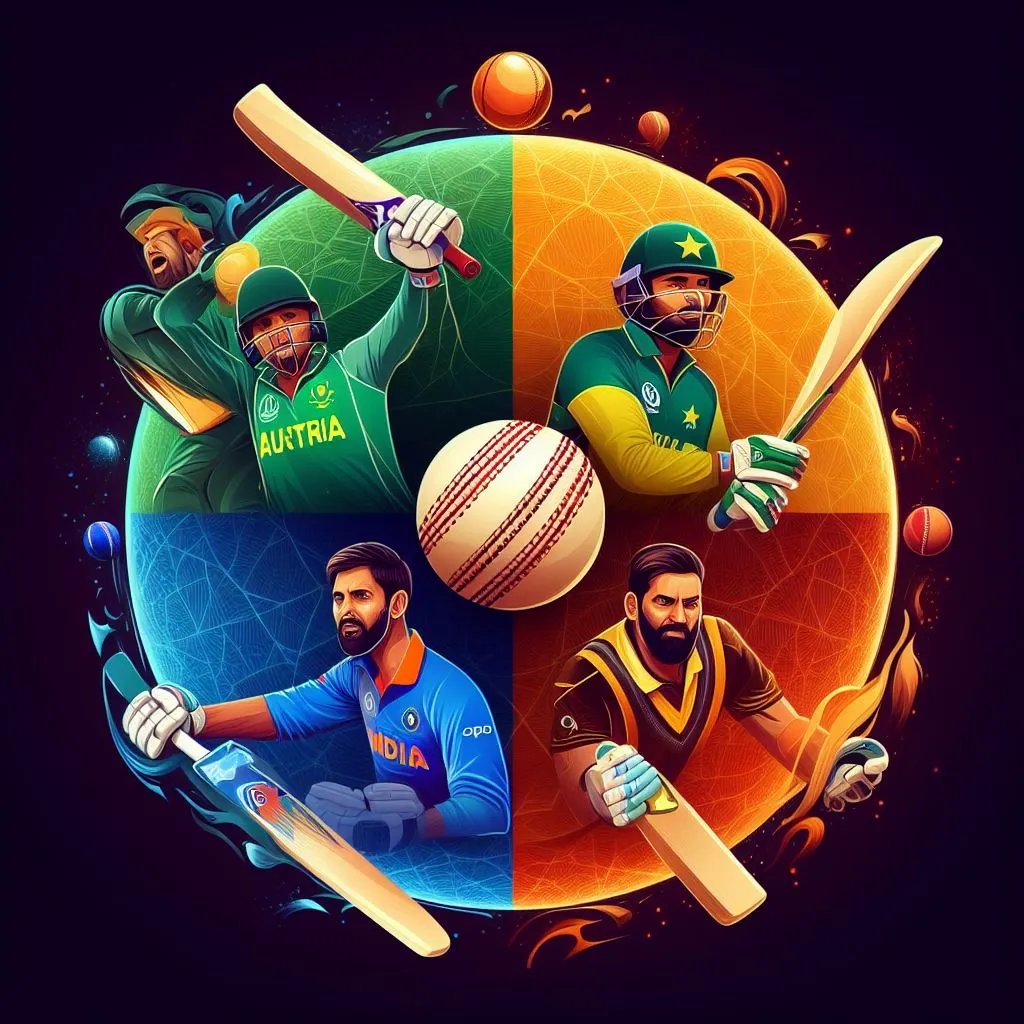Cricket is a bat-and-ball game played between two teams of eleven players on a field at the center of which is a 22-yard (20-meter) pitch with a wicket at each end, each comprising two bails balanced on three stumps.
There are three main formats of cricket: Test cricket, One-Day Internationals (ODIs), and Twenty20 Internationals (T20Is). These formats differ in terms of the number of overs per inning, the length of the match, and the rules of the game.
- Test cricket is the oldest and most traditional format of the game. It is played over five days, with each team batting twice. There is no limit on the number of overs bowled in each innings.
- ODIs are played over one day, with each team batting once. Each team has 50 overs to bat.
- T20Is are the shortest format of cricket, with each team batting for 20 overs.
Test cricket is known for its slow and deliberate pace, and its emphasis on strategy and technique. ODIs are more fast-paced and exciting, and T20Is are the most fast-paced and explosive format of the game.
All three formats of cricket are popular around the world, but each format has its unique appeal. Test cricket is popular with fans who appreciate the traditional aspects of the game and the skill and patience required to be successful. ODIs are popular with fans who enjoy the excitement and unpredictability of one-day cricket. T20Is are popular with fans who enjoy the fast-paced and explosive action of the shortest format of the game.
In the following sections, we will take a closer look at each of the three formats of cricket, including the game’s rules, the strategies used by the teams, and the skills required by the players.
Test cricket rules

Test cricket is the oldest and most traditional format of cricket, played over five days. Each team bats twice, and there is no limit on the number of overs bowled in each innings. Test cricket is known for its slow and deliberate pace, and its emphasis on strategy and technique.
The basics
- A Test match is played between two teams of eleven players each.
- Each team bats twice, and the team with the most runs at the end of the match wins.
- There is no limit on the number of overs bowled in each innings.
- A Test match can be drawn if the scores are level at the end of the match, or if the time runs out before either team can be dismissed twice.
Bowling
- The bowling team tries to dismiss all ten of the batting team’s batsmen.
- A bowler bowls one over at a time, which consists of six balls.
- The bowler can bowl a variety of different deliveries, including fastballs, spin balls, and slower balls.
- The wicketkeeper is a fielder who stands behind the stumps at the bowler’s end. They are responsible for catching the ball if it is hit by the batsman and goes past the stumps.
Batting
- The batting team tries to score as many runs as possible before all ten of their batsmen are dismissed.
- A batsman score runs by hitting the ball and running between the wickets.
- If the ball hits the stumps and dislodges the bails, the batsman is out.
- There are several other ways to get out, including being caught by a fielder, being run out, or being given out LBW (leg before wicket).
Fielding
- The fielding team tries to prevent the batting team from scoring runs and dismissing their batsmen.
- The fielding team is spread out around the field, with some fielders close to the stumps and others further away.
- When the ball is hit, the fielders try to stop it from reaching the boundary and to field it so that they can throw it to the wicketkeeper or another fielder to dismiss the batsman.
Runs and wickets
- A run is scored when both batsmen cross the crease at the other end after hitting the ball.
- A wicket is lost when a batsman is dismissed.
- The team with the most runs at the end of the match wins.
Other important rules
- There are some other important rules in Test cricket, including:
- The bowler cannot bowl two consecutive balls that bounce more than once before reaching the batsman (this is called a double bounce).
- The batsman cannot hinder the bowler’s progress to the wicket.
- The fielders cannot obstruct the batsman’s view of the ball.
- The ball must be bowled overarm.
Declaration
- The captain of the batting team can declare their innings closed at any time. This means that they are giving up the chance to bat again and are setting the bowling team a target to score to win the match.
Follow-on
- If the batting team is dismissed in their first innings and their total is at least 200 runs less than the bowling team’s total, the bowling team can enforce the follow-on. This means that the batting team must bat again immediately.
Winning and losing
- The team with the most runs at the end of the match wins.
- If the scores are level at the end of the match, the match is drawn.
- If the time runs out before either team can be dismissed twice, the match is drawn.
Conclusion
Test cricket is a complex and challenging game, but it is also one of the most rewarding sports to watch and play. The rules of Test cricket can be difficult to learn at first, but with a little practice, you will be able to understand and appreciate the game’s finer points.
One-Day International (ODI) cricket rules

One-Day Internationals (ODIs) are a form of limited-overs cricket, played between two teams with international status, in which each team faces a fixed number of overs, currently 50, with the game lasting up to 7 hours. The Cricket World Cup, generally held every four years, is played in this format. One Day International matches are also called Limited Overs Internationals (LOI), although this generic term may also refer to Twenty20 International matches. They are major matches and are considered the highest standard of List A, limited-overs competition.
ODI match overview
- An ODI match is played between two teams of eleven players each.
- Each team bats once, and the team with the most runs at the end of the match wins.
- Each team has 50 overs to bat. An over consists of 6 balls bowled by one bowler.
- If the batting team is dismissed before all 50 overs are bowled, their innings is over.
- The fielding team tries to prevent the batting team from scoring runs and dismissing their batsmen.
- There are many ways to get out, including being bowled, caught, run out, or given out leg before wicket (LBW).
ODI rules and regulations
- The bowler cannot bowl two consecutive bouncers (balls that bounce more than once before reaching the batsman).
- The batsman cannot hinder the bowler’s progress to the wicket.
- The fielders cannot obstruct the batsman’s view of the ball.
- The ball must be bowled overarm.
- The fielding team can only have two fielders outside the 30-yard circle during the powerplay (the first 10 overs of each innings).
- The fielding team can only have four fielders outside the 30-yard circle at any other time during the innings.
ODI strategies
- The strategies used by teams in ODI cricket vary depending on the conditions and the opposition. However, there are some general principles that teams follow:
- The batting team tries to score as quickly as possible in the powerplay and then consolidate their position in the middle overs.
- The fielding team tries to take wickets in the powerplay and then restricts the batting team’s scoring rate in the middle overs.
- The batting team tries to accelerate their scoring rate in the final overs to set a challenging target for the fielding team.
- The fielding team tries to bowl tightly in the final overs and to take wickets to win the match.
ODI skills
- The skills required to be successful in ODI cricket include:
- Batting skills: Batsmen need to be able to score quickly and to hit the ball to all parts of the ground.
- Bowling skills: Bowlers need to be able to bowl accurately and to take wickets.
- Fielding skills: Fielders need to be able to catch the ball cleanly and to throw accurately.
- Running skills: Batsmen and fielders need to be able to run quickly between the wickets.
Conclusion
ODI cricket is a fast-paced and exciting format of the game. It is a popular format with fans around the world, and it is the format in which the Cricket World Cup is played. ODI cricket requires a wide range of skills from the players, including batting, bowling, fielding, and running.
Twenty20 International (T20I) cricket rules
Twenty20 International (T20I) cricket is the shortest format of cricket, with each team batting for 20 overs. It is a fast-paced and exciting format of the game that has become very popular in recent years.
T20I match overview
- A T20I match is played between two teams of eleven players each.
- Each team bats once, and the team with the most runs at the end of the match wins.
- Each team has 20 overs to bat. An over consists of 6 balls bowled by one bowler.
- If the batting team is dismissed before all 20 overs are bowled, their innings is over.
- The fielding team tries to prevent the batting team from scoring runs and dismissing their batsmen.
- There are some ways to get out, including being bowled, caught, run out, or given out leg before wicket (LBW).
T20I rules and regulations
- The following are some of the key rules and regulations of T20I cricket:
- The bowler cannot bowl two consecutive bouncers (balls that bounce more than once before reaching the batsman).
- The batsman cannot hinder the bowler’s progress to the wicket.
- The fielders cannot obstruct the batsman’s view of the ball.
- The ball must be bowled overarm.
- The fielding team can only have five fielders outside the 30-yard circle for the entire innings.
- The bowling team must complete their 20 overs within 75 minutes.
T20I strategies
- The strategies used by teams in T20I cricket vary depending on the conditions and the opposition. However, there are some general principles that teams follow:
- The batting team tries to score as quickly as possible from the start of their innings.
- The fielding team tries to take early wickets and to restrict the batting team’s scoring rate.
- The batting team tries to accelerate their scoring rate in the final overs to set a challenging target for the fielding team.
- The fielding team tries to bowl tightly in the final overs and to take wickets to win the match.
T20I skills
- The skills required to be successful in T20I cricket include:
- Big-hitting skills: Batsmen need to be able to hit the ball hard and to clear the boundary.
- Death bowling skills: Bowlers need to be able to bowl accurately and to take wickets in the final overs.
- Fielding skills: Fielders need to be able to catch the ball cleanly and to throw accurately.
- Running skills: Batsmen and fielders need to be able to run quickly between the wickets.
Conclusion
T20I cricket is a fast-paced and exciting format of the game that has become very popular in recent years. It is a format of the game that requires a wide range of skills from the players, including big-hitting, death bowling, fielding, and running.
Here are some additional T20I rules and regulations:
- A bowler can bowl no more than four overs in a T20I innings.
- If a bowler bowls a no-ball, the batting team is awarded one run and the bowler cannot bowl another no-ball until they have completed their over.
- If a fielder bowls a wide ball, the batting team is awarded one run and the bowler cannot bowl another wide ball until they have completed their over.
- If a batsman is given out LBW, the ball counts as one delivery and the bowler cannot bowl another LBW ball until they have completed their over.
- If the batting team is dismissed for less than 100 runs in a T20I match, the fielding team is awarded a bonus point.
- If the chasing team wins a T20I match by a margin of 10 wickets or more, they are awarded a bonus point.
T20I Super Over
- If a T20I match is tied at the end of the regulation overs, a Super Over is played to decide the winner.
- In a Super Over, each team bats for one over, with the team scoring the most runs winning the match.
- If the Super Over is also tied, the team that lost the fewest wickets in the regulation overs wins the match.



